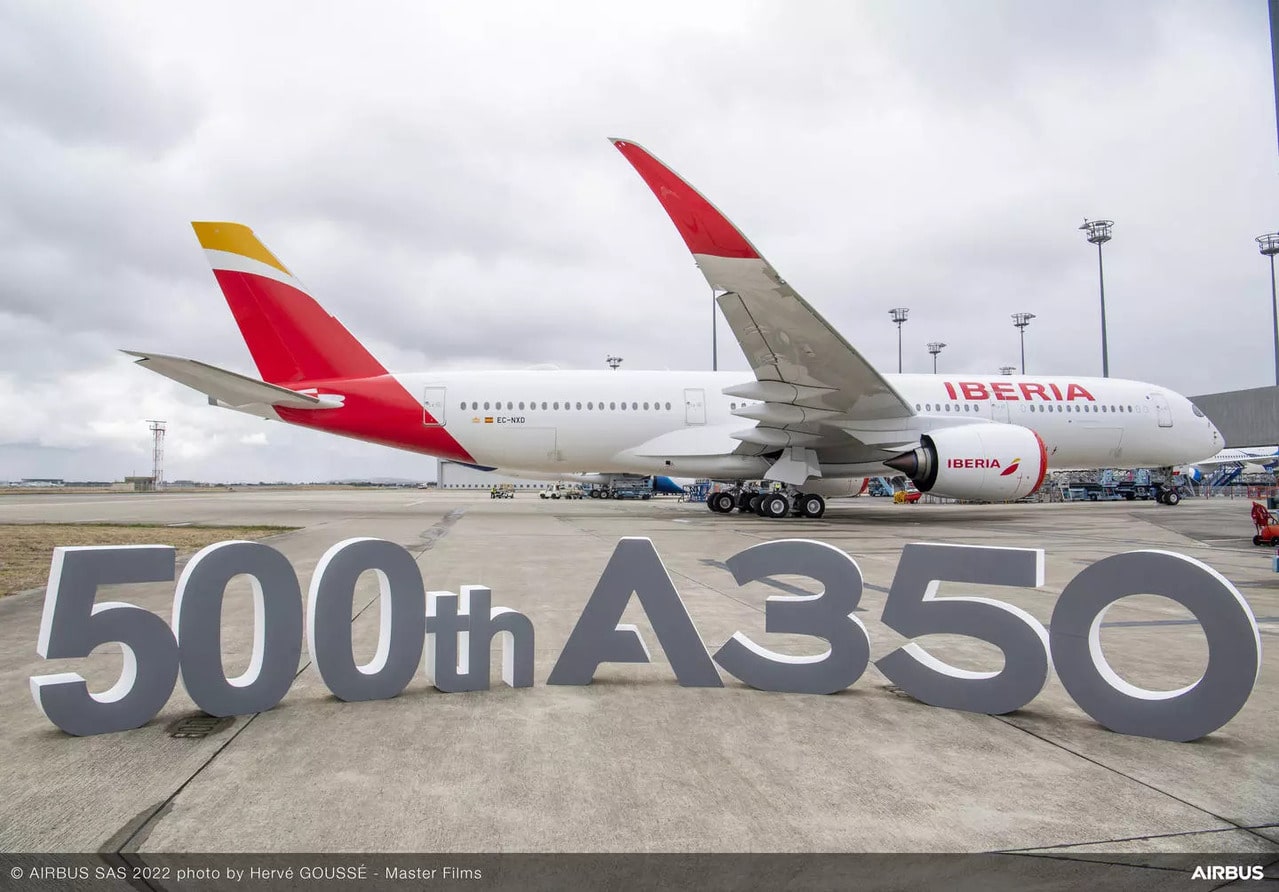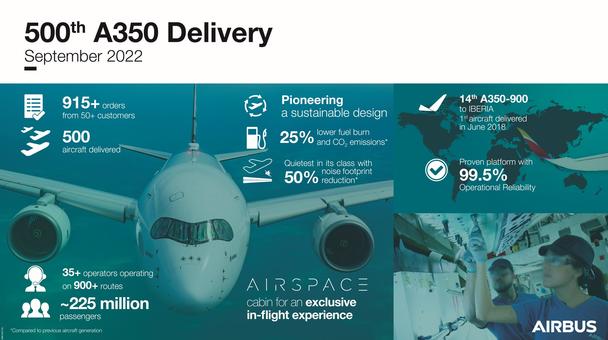Aerospace
Airbus delivers its 500th A350
Airbus delivers its 500th A350 and introduces its new Production Standard 2022. 225 million passengers, more than 900 routes, and more than 400 backlogged orders.

Airbus delivers its 500th A350 and introduces its new Production Standard 2022. 225 million passengers, more than 900 routes, and more than 400 backlogged orders. Airbus will deliver its 500th A350 to Iberia towards the end of September 2022 as part of the celebration. With the achievement of this landmark, the A350 Family’s global expansion proceeds.
The 500th A350 – an A350-900 – was recently delivered to Iberia, a major European customer with 20 A350s on order and 14 in service. Beyond a symbol, the 500th A350 marks an important milestone for Airbus and its growing versatile family, now including the A350-900, the A350-1000 and the newest Airbus freighter A350F.
Eight years after entering service, operators continue to be attracted to the A350 family of aircraft because of their improved performance, 25% lower fuel consumption, CO2 emissions, and noise footprint, as well as their great efficiency, which can go up to 9,700 nm (18 000 km).
Introducing the A350 new Production Standard
This 500th delivery also marks the introduction of the new Production Standard 2022 which brings additional performance and cabin improvements for both A350-900 and A350-1000. Compared to previous standards, it brings a weight reduction of up to 1.2 tonnes by optimizing systems and structures and increasing the use of advanced materials which already represent more than 70% of the aircraft. The Maximum Takeoff Weight is also increased by 3 tonnes allowing each model to maintain its maximum range capability, beyond 8,000nm, while carrying an increased payload.
Through these upgrades, operators may operate more profitably and adaptably while giving passengers more room and comfort in the quietest cabin in its class. Additionally, it puts the A350 platform in a position to be ready for emerging trends like decarbonization technologies, a major motivator for operators.

Aerospace
Boeing Transfers Rocket Stage to NASA, Paving Way for Human Moon Mission

Boeing has achieved a significant milestone by providing NASA with the second core stage of the Space Launch System (SLS) rocket.
This crucial component, crafted at NASA’s Michoud Assembly Facility (MAF), is set to propel the Artemis II crew into lunar orbit, marking humanity’s return to deep space after a 50-year hiatus.
The monumental Boeing-built rocket stage, the largest element of the Artemis II mission, will embark on a journey aboard the Pegasus barge, traveling 900 miles to NASA’s Kennedy Space Center.
Comparison of two legendary aircraft B777x vs B747 aircraft:Click here
Upon arrival, it will be meticulously integrated with other essential Artemis II components, including the upper stage, solid rocket boosters, and NASA’s Orion spacecraft within the iconic Vehicle Assembly Building. This intricate integration process is a vital step toward the eagerly anticipated Artemis II launch, slated for 2025.
“Boeing-built products helped land humankind on the moon in 1969, and we’re proud to continue that legacy through the Artemis generation,” remarked Dave Dutcher, vice president and program manager for Boeing’s SLS program. “Together, with NASA and our industry partners and suppliers, we are building the world’s most capable rocket and paving the way to deep space through America’s rocket factory in New Orleans.”
NASA, Lockheed Martin Reveal X-59 Quiet Supersonic Aircraft:Click here
The delivery of Core Stage 2 marks a significant achievement in the evolution of the SLS rocket. Towering over 200 feet and powered by four RS-25 engines, this core stage, coupled with two solid-fueled booster rockets, will generate a staggering 8.8 million pounds of thrust. This immense power is crucial to launching Artemis II and future missions into the vast expanse of space.
The SLS rocket stands unparalleled in its capability to transport both crew and substantial cargo to the moon and beyond in a single launch. Its extraordinary capacity will facilitate the delivery of human-rated spacecraft, habitats, and scientific missions to destinations including the moon and Mars, ushering in a new era of space exploration.
-

 Travel1 week ago
Travel1 week agoAir India to Expand US Operations with Three New Routes After a Decade
-

 Travel2 weeks ago
Travel2 weeks agoWhy We Should Avoid These Stamps in a Passport
-

 Airlines1 month ago
Airlines1 month agoInvestigations Reveal Fake Chinese Titanium in Boeing and Airbus Jets
-

 Tech4 weeks ago
Tech4 weeks agoChina’s CATL Plans 1,800-Mile Electric Plane Launch by 2027
-

 Airport3 days ago
Airport3 days agoTop 10 Largest Airports in the World by Size
-

 Aerospace4 weeks ago
Aerospace4 weeks agoChina’s Fighter Jets Turn Wings into Autonomous Drones
-

 Airlines4 days ago
Airlines4 days agoAir India Rolls Out A350s for Delhi-New York JFK and Newark Routes
-

 Defence3 weeks ago
Defence3 weeks agoBoeing Enhances Chinook with New Engines and Block II Upgrades at $96 Million








